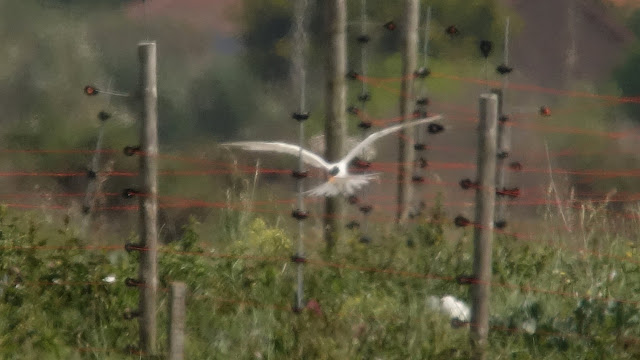With news of a putative Elegant Tern being found in Hampshire in early June, it was sure to attract a fair few admirers. The species has been reported on a number of occasions in the UK, (5 accepted and 3 pending), but most of the previous records have been tarred by the messy prominence of hybridization within the species in Europe. A number of birds have been semi-resident in Sandwich Tern colonies on the Atlantic coast for many years, and have allowed for close study while they hybridized with Sandwich Terns.
It is particularly the results from this study that interest many listers in a UK sense. This bird, along with 3 others, all of which show Elegant Tern like plumage have been caught, colour ringed and DNA analysed. Cut short, the results showed that the hybrid offspring do not resemble Elegant Terns in any way, and the original adults that were tested using DNA, matched specimens of pure Elegant Terns from the pacific coasts of the USA.
And the Hayling Island bird? It was soon confirmed to be a colour ringed male, and with DNA confirmation, it proved without doubt that this was an Elegant Tern. In terms of listing within the UK, the first unequivocally confirmed Elegant Tern was sure to attract a big crowd... Had the bird stuck around...
A couple of brief appearances followed, each lasting around an hour, before eventually the bird was tracked down in the Tern colony within Pagham Harbour, on the other side of the Selsey peninsula.
11/06/17
Plans for a day birding at Ham Wall was postponed so we could join in the excitement of a UK 'orange-billed' Tern. As we approached Hayling Island en route to Pagham, news circulated that the bird had flown out to sea. Having seen the birds routine the previous day, of going out to feed every 3-4 hours, for around 2 hours each time. So a quick stop, breakfast, coffee and we drove the remaining 15 minutes around an hour later.
20 minutes later, after leaving a crammed RSPB carpark and we saw the crowd. And a rather large one it was!
The bird still hadn't returned, but we were entertained by frolicking flocks of Med Gulls, hovering Little Terns and flocking Sandwich Terns.
Around an hour later, a shout came that the bird was flying back in, but before anyone could react, it had dropped down onto 'its' spot in the colony, out of sight, and leaving a good few hundred birders without a view!
A tense 10 minute wait, after patiently having the scope fixated on the area were it dropped in, and up flew a carrot billed large Tern. It hovered around for about 5 seconds, before dropping down again. This process was repeated a few times across the next hour, as we pieced together views of this world lifer for both of us.
Eventually, after a couple of brief flights around the Tern island, the bird took a more distant circular route around the harbour, giving its closest view so far, before it flew across the seawall and out to sea.
And on that, we chose the walk home, together with a quick drop into the New Forest.



